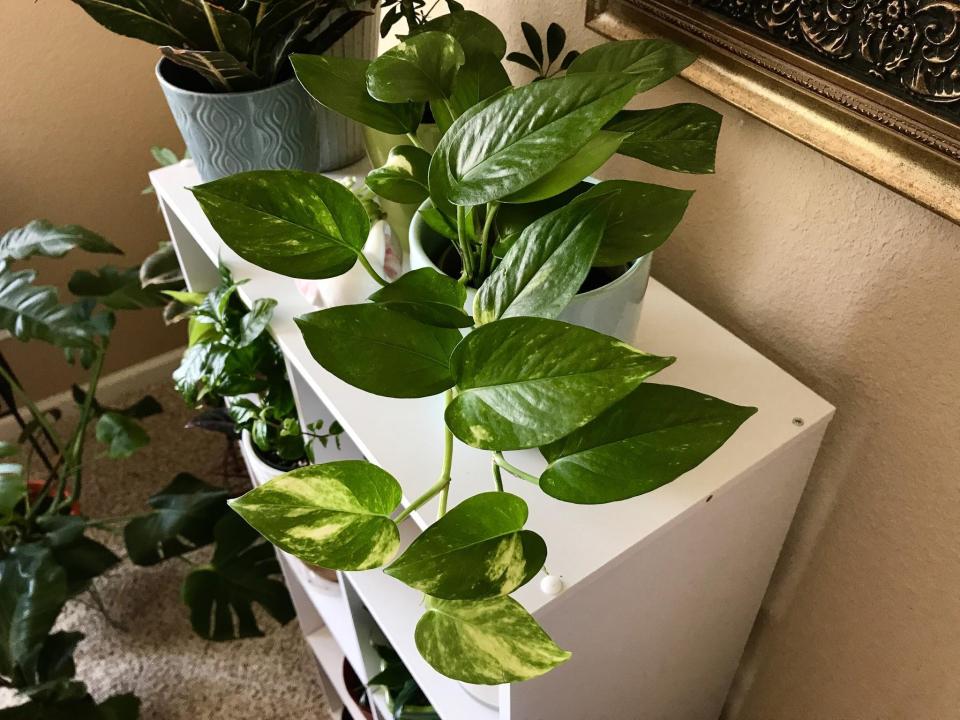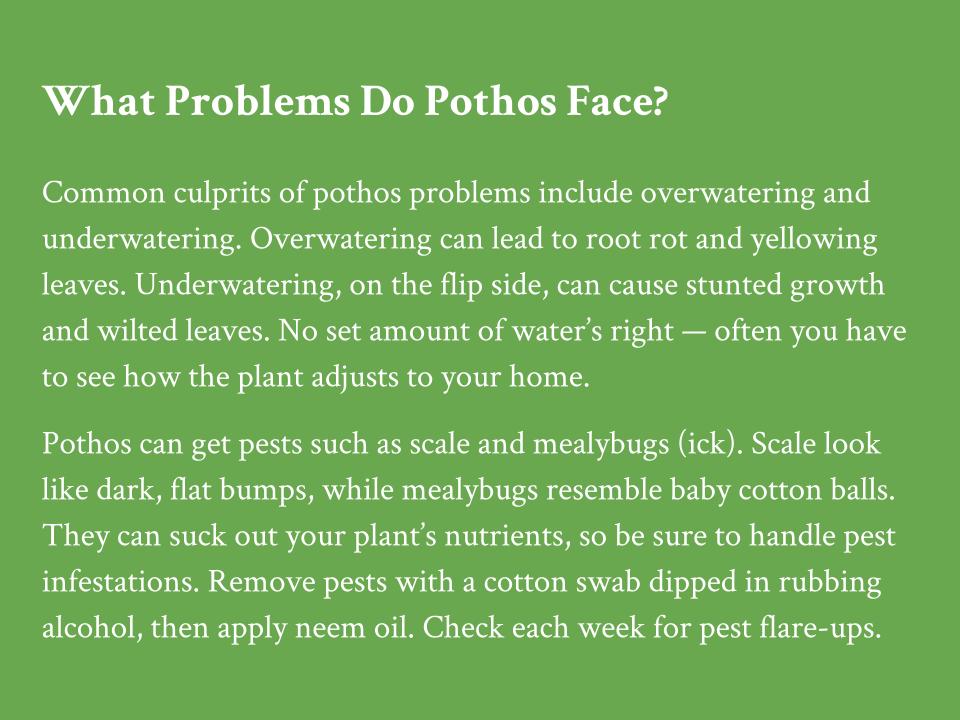An Introduction to Pothos
As far as houseplants go, pothos are notoriously easy to maintain. At least that’s what they say. I’ve gone through two plants before finding the right routine for my golden pothos. But with ample indirect sunlight and light watering, you’ll have yourself a loyal green friend.
What I love about the pothos is that it feels like a plant of the people. For under $10, you can get a robust plant from pretty much anywhere, whether it’s your local nursery or a chain supermarket. The pothos is down-to-earth, frills-free, steadfast — a workhorse trailing plant that minds its own business and grows prolifically!

How Do You Identify a Pothos?
It’s easy to spot a pothos. Native to the Solomon Islands, pothos consist of waxy, heart-shaped leaves that trail. However, they sometimes get confused with philodendron…which also have waxy, heart-shaped leaves that trail. Here’s a quick and easy way to distinguish between them: A pothos leaf tends to be thicker and has an indentation line through the middle of it.
Pothos also have wider aerial roots, which help them attach to trees in nature. With the right conditions, they can grow up to 20 to 40 feet long over time. Oh, and one more thing: pothos don’t usually flower.

Where Does the Term Pothos Come From?
In Greek mythology, Pothos was an Erote, a love-god who was Aphrodite’s son and Eros’ brother. Pothos’ turf, specifically, was that of passionate longing.
The scientific name for pothos is Epipremnum aureum. “Epi” is Greek for upon, while “premnon” means trunk — pothos typically grow on tree trunks in nature. Aureum refers to gold.
People also colloquially call pothos devil’s ivy because of its knack for surviving harsh conditions.
What Kind of Pothos Are There?
There are many different kinds of pothos, including neon, marble queen, pearls and jade, N’ Joy, and Manjula. The most popular kinds are jade and golden pothos. The former is strictly green, while the other has splashes of yellow, though it will turn green without sufficient sunlight.
How Do You Care for Pothos?
Pothos are steely plants, often resilient in difficult conditions. Indoors pothos thrive on plenty of indirect sunlight and prefer to be dried out in between waterings. They can grow at different temperatures, but their ideal range is 70-90° F.
Pothos aren’t picky when it comes to soil and fertilizer. A regular potting mix with good drainage should be sufficient. They don’t really need fertilizer, but you can encourage growth by fertilizing them with an all-purpose houseplant fertilizer every two weeks during active growth periods.
Extra info not in the slides: To propagate a pothos, take a cutting below a node and stick it in clean water. Leave your cutting by the window and watch roots grow! When the roots look long and healthy enough, you can stick it in fresh soil to make a new plant.
What Problems Do Pothos Face?
Common culprits of pothos problems include overwatering and underwatering. Overwatering can lead to root rot and yellow leaves. Underwatering, on the flip side, can cause stunted growth and wilted leaves. No set amount of water’s right — often you have to see how the plant adjusts to your home.
Pothos can get pests such as scale and mealybugs (ick). Scale look like dark, flat bumps, while mealybugs resemble baby cotton balls. They can suck out your plant’s nutrients, so be sure to handle pest infestations. Remove pests with a cotton swab dipped in rubbing alcohol, then apply neem oil. Check each week for pest flare-ups.
Sources
- https://homeguides.sfgate.com/long-can-pothos-ivy-live-89690.html
- https://homeguides.sfgate.com/differences-between-golden-pothos-heartleaf-philodendron-59737.html
- https://www.theoi.com/Ouranios/ErosPothos.html
- https://mrec.ifas.ufl.edu/Foliage/folnotes/pothos.htm#:~:text=Pothos%20will%20survive%20a%20wide,F%20will%20greatly%20retard%20growth
- https://www.gardeningchannel.com/pothos-plant-devils-ivy-care/
- https://www.missouribotanicalgarden.org/PlantFinder/PlantFinderDetails.aspx?taxonid=276360&isprofile=0&
Slides
Scroll through for all of the same information in slide form!












2 thoughts on “A Short and Simple Guide to Pothos”